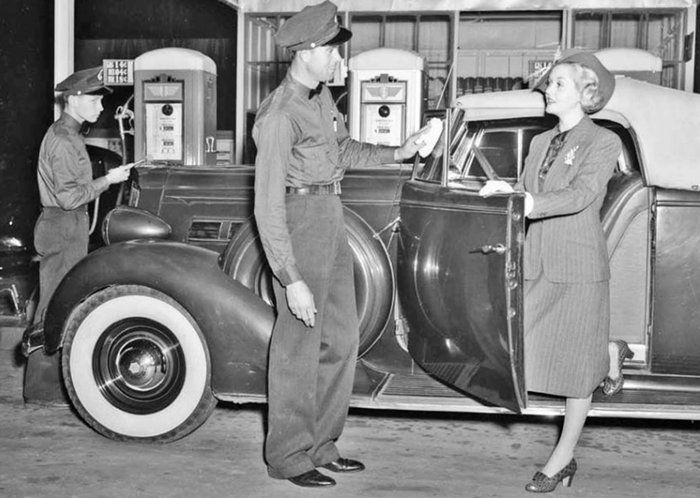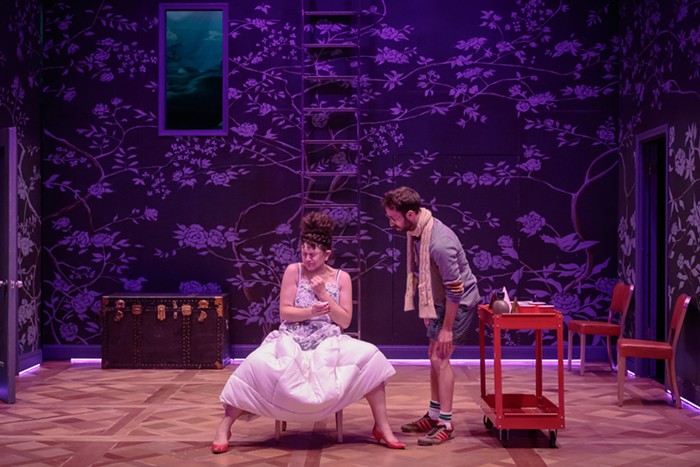Daniel Duford and Meg Rowe deal with these issues directly, through drawing, sculpture, and installation. Duford's Checkpoint (Red) and The Audience (Green) are claustrophobic pastel and charcoal drawings based on the New York Times' ongoing "Nation at War" coverage. One depicts a hooded and goateed man flat on the ground being frisked, and the other is a chilling scene of three men in business suits shaking hands, presumably controlling much of the world as we know it. Shirts vs. Skins is a miniature, three-dimensional orgy of violence and grief executed in neon Sculpey. Reminiscent of Chandra Bocci's This Would Suck a Lot Less, armies of indistinguishable members kill and maim each other, while the wounded sit aside in disfigured despair.
Meg Rowe's Here/There Us/Them Before/After is a personal homage to Ground Zero, incorporating a sheet of plastic that the artist brought home from the WTC site, snapshots of her Irvington neighborhood, maps of Manhattan, and lines of blue thread that dart through the entire collage. The point seems to be that we're more conscientious of how we define "home," and how New York has become the de facto heartbeat/spiritual home for much of America--but the artist's execution was vague at best.
There exists a growing trend toward issues of home and notions of traditional domesticity among artists, as evidenced by the insane numbers of men and women who have begun crocheting at neurotic and antisocial paces. Nan Curtis and Martin Houston don't knit, but their work is based in an exploration of the home front. Houston's 24 Drawings of a Door is one of the most satisfying sculptures I've seen this year. Suspended from the ceiling and hovering a few millimeters above the floor is a glass and steel frame, containing vertical strips of an antique door. Each slice has been spun sideways, then put back together, so all viewers see are the "guts" of the door--sensuous raw wood--while its original public face remains out of view.
An ornate, flowery gold frame surrounds Curtis's Stained Carpet, which is exactly what it sounds like. The white carpet in question was used in another artwork last year, but at the show's opening a gallery patron spilled red wine into the pristine shag, prompting Nan to make some proverbial lemonade. Disturbingly, though, the stain looks like a cracked skull hit the floor about a month ago, and the evidence has been framed like a trophy for the mantle.
Just opposite Curtis's glorified stain is an untitled floor sculpture by Chris Gander. Extremely minimalist, the piece consists of two box shapes--one smaller rectangle jutting off of another. Standing in the right spot, though, the piece looks comically like a blocky cartoon head (from Krazy Kat perhaps) that tumbled to the floor like a deflated balloon from the Macy's Day parade.
Paul Arensmeyer's Dog is an absurd but endearing sculpture consisting of a propeller affixed to a small, grimy antler. Of the countless interpretations that Dog invites, I like the one about how all man needs for his "best friend" is locomotion and a little ornamentation.
Another trend that has been picking up steam with international practitioners such as Matthew Barney and Trenton Doyle Hancock is one of super-private narratives that audiences are allowed to peek in on, but never given maps to. Meredith Hamm's fantasy-based drawings fit this model, with bug-eyed characters living in numerical worlds where numbers grow on trees and appear on skating rink floors. Hamm's watercolor and cross hatch techniques are appealing, but the subjects are impenetrable.
It's a real shame that local art of this quality and sophistication is showing at a student sculpture gallery for lack of a better venue. In a professional, non-profit art gallery, this show would shine and show off some of Portland's best artists. More than anything, this city needs a non-commercial space with clean white walls, regular gallery hours, and a dedication to local, challenging artwork. The DIY spirit is good as far as it goes, but shows like Home and Away indicate that Portland is ready to go further. CHAS BOWIE












